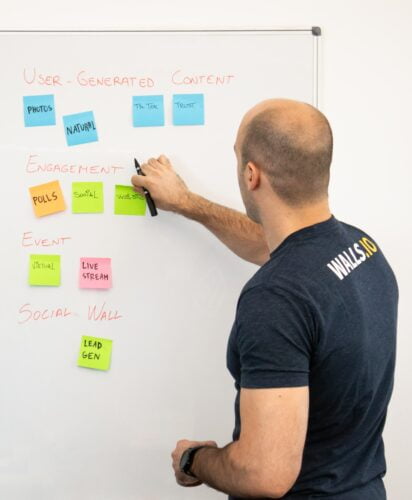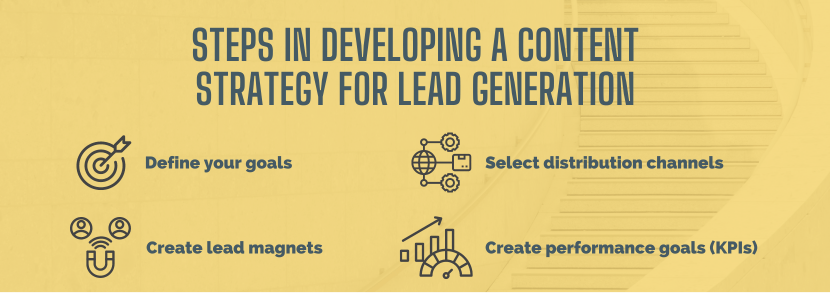Content marketing is a crucial strategy for brands looking to generate leads in this digital age. 76% of content marketers use content to generate leads, primarily because well-crafted content can pique people’s interest and convince them to take action unless other passive lead generation strategies (97% of people ignore cold calls).
Content marketing for lead generation involves creating engaging, informative content that speaks directly to your target audience and provides them with valuable information about your product or service.
By leveraging the right content – such as blog posts, how-to guides, social media posts, video tutorials, ebooks, lead magnets, and more – you can attract the attention of potential leads and drive them down the content marketing funnel.
In this article, we’ll explore the best content marketing strategies you can use to generate leads. From understanding your target audience to leveraging SEO, content marketing funnels and creating effective lead generation content calls-to-action, this guide will provide you with all the information you need to start successful content marketing campaigns and lead generating campaigns.
Understanding your target audience: creating buyer personas
Knowing your target audience inside and out is the foundation of any successful marketing strategy, especially when it comes to content marketing for lead generation.
Your target audience is the group of people most likely to benefit from your product or service. They’re the ones who will have a real interest in your brand, and, most importantly, they’re the ones who are most likely to convert leads from casual browsers into paying customers.
To truly understand your target audience’s attention, you must go beyond basic demographics like age, gender, and location. You should also consider psychographics such as lifestyle, values, attitudes, and behaviors. This is where creating buyer personas comes in.
What’s the purpose of buyer personas?
Buyer personas are detailed, semi-fictional representations of your ideal customers, often created by the sales team.
They can help you understand your customers (and prospective customers) better and make it easier for you to tailor your content, messaging, product development, and services to different groups’ specific needs, behaviors, and concerns.
How are buyer personas created?
Creating buyer personas involves thorough market research and insights from your existing customer base.
You might conduct surveys, interviews, focus groups, or delve into your customer database and analytics to unearth trends about how certain customers use your products and services and gather feedback about their experiences.
A comprehensive buyer persona will cover everything from demographic information to hobbies and interests, preferred social media platforms, and common challenges or pain points that your product or service can address. The more detailed your buyer personas are, the better you can tailor your content marketing strategy to attract and engage your ideal customers and drive lead generation.
Developing a content marketing strategy for lead generation
Once you have a clear understanding of your target audience and have created detailed buyer personas for specific keywords, the next step is to develop a content funnel strategy aimed at generating leads.
Your content funnel strategy is the roadmap that guides your content marketing efforts, helping you plan, create content for, manage, and optimize your content to meet your lead generation goals. Content marketing funnel stages will also determine the method and cadence that you dispense this content to your prospective audience.
Developing a content strategy funnel for lead generation involves several key steps.
1. Define your goals
First, you need to define your goals.
Are you looking to create content to attract new leads, nurture existing ones, or both? Your goals will shape your lead generation content strategy, influencing the type of content you create (i.e., middle of funnel content) and how you distribute it.
2. Create lead magnets
Next, you need to decide on the types of lead magnet content you will create.
There are many forms of content that can drive lead generation, from blog posts and articles to e-books, videos, webinars, infographics, and more. The type of lead generating content you choose to create should depend on what resonates best with your target audience.
3. Select distribution channels
You also want to identify the channels you will use to distribute your content funnel stages, which could impact the lead magnets you create.
These channels might include your website landing pages, new blog posts, social media platforms, email marketing campaigns, or third-party websites.
4. Create performance goals (KPIs)
Your content strategy funnel should also outline a clear plan for measuring and analyzing the performance of your content.
This might involve tracking metrics like page views, bounce rate, time spent on your home page, social shares, comments, and conversion rate.
Remember, the goal of your content strategy is to generate high-quality leads. This means focusing not just on the total number of leads you generate but also on the number of high-quality leads. By aligning your content promotion strategy with your buyer personas, you can ensure you’re attracting the right kind of leads – ones who are most likely to convert into customers.
Creating compelling and relevant content to generate leads
Once you’ve built your buyer personas and developed your content strategy, the next step is to create compelling, relevant content. Your content should not only capture the interest of your target audience but also offer them something of value – information, insights, ideas, solutions to their problems, or simply entertainment.
Creating compelling content starts with understanding what your audience finds valuable. For instance, if your buyer persona is a small business owner looking to increase their online presence, they might find value in a detailed guide to SEO, a video tutorial on using social media for business, or a case study highlighting a successful digital marketing campaign.
Once you know what kind of content your audience values, focus on creating great content and making it as engaging and compelling as possible. This could involve using storytelling techniques, incorporating eye-catching visuals, or using a conversational tone to make your content more relatable and personable.
Relevance is another crucial aspect of compelling content.
The more relevant your content is to your audience, the more likely they are to engage with it and, ultimately, convert it into leads. Relevance can be achieved by addressing the specific problems or needs of your buyer personas, offering solutions directly related to your products or services, and staying up-to-date with industry trends and news.
Remember, creating compelling and relevant content is not a one-time task. It should be an ongoing effort, with continuous optimization based on audience feedback and performance analysis.
Optimizing content for search engines and lead capture
Having compelling, relevant content is just part of the equation – you also need to ensure that your content is easily discoverable by your target audience and optimized for lead capture.
Search Engine Optimization (SEO) is a critical component of this. By researching and doing keyword research using relevant keywords and long tail keywords, optimizing your meta tags, and ensuring that your content is easily readable by search engine algorithms, you can help your content rank higher in organic search and engine results, making it more discoverable by potential leads.
Beyond SEO, optimizing your content for lead capture involves strategically incorporating calls-to-action (CTAs) and lead capture forms in your content.
CTAs are prompts that encourage readers to take a specific action, like subscribing to your newsletter, downloading an e-book, or registering for a webinar. These CTAs should be relevant to the content and offer something of value in return for the reader’s contact information.
Similarly, lead capture forms – whether they’re part of a landing page or embedded within your content – should be straightforward and easy to fill out, asking for just enough information to help you follow up with leads without overwhelming them.
Keep in mind that optimizing your content for search engines and lead capture is not a set-it-and-forget-it process. SEO algorithms and audience preferences evolve over time, so it’s important to periodically review and update your optimization strategies to stay competitive and maximize your lead generation potential.
Leveraging social media for lead generation
Social media is a powerful tool for lead generation. It offers a platform to reach and engage your target audience directly.
Utilize social media to share valuable content, promote offers, and engage in conversations that foster relationships with your audience. Optimize your profile to include clear CTAs that direct visitors to landing pages or host live Q&A sessions to provide value and collect contact information. With its precise targeting options, paid social media advertising is also an excellent way to reach potential leads. Remember to monitor social media analytics to understand your audience’s behaviors and preferences and optimize your efforts accordingly.
Using email marketing to nurture leads
Email marketing remains one of the most effective ways to nurture leads. Once a visitor shows interest and shares their email address, it’s your chance to deepen the relationship.
Develop personalized email sequences to guide leads through your sales and content marketing funnel, offering value at each step. From educational content and product demonstrations to exclusive offers, every email should bring your lead closer to a purchase decision. Automate your email marketing to ensure timely communication, and always track email metrics to understand engagement and optimize your campaigns.
Incorporating interactive content for increased engagement
Interactive content, like quizzes, polls, calculators, or interactive infographics, adds a dynamic element to your content marketing strategy. It actively involves your audience, increasing engagement and providing a more personalized experience.
Interactive content can help you gather valuable insights about your audience’s preferences, needs, and behaviors. More importantly, they can serve as a creative lead generation tool – to access results or insights, users often provide their contact information to access results or insights, adding to your lead pool. Remember to align your interactive content with your overall content strategy and buyer personas for maximum effectiveness.
The power of video marketing in lead generation
Video content has seen a surge in popularity, and for good reason. It’s engaging, versatile, and can simplify complex topics. For lead generation, videos can demo products, share customer testimonials, or offer educational content.
Include clear CTAs within your videos to direct viewers to landing pages or sign-up forms. Platforms like YouTube also offer video SEO, expanding your discoverability. Live video sessions on platforms like Facebook, Instagram, or LinkedIn can foster real-time interaction, creating a sense of community and trust with your audience. Keep videos succinct, engaging, and always aligned with your brand and content strategy.
Measuring and analyzing content marketing performance
 Effectively measuring and analyzing the performance of your content marketing efforts is a critical part of any successful lead generation strategy. Without knowing what’s working, what’s not, and why, you can’t make informed decisions or create targeted strategies for improvement.
Effectively measuring and analyzing the performance of your content marketing efforts is a critical part of any successful lead generation strategy. Without knowing what’s working, what’s not, and why, you can’t make informed decisions or create targeted strategies for improvement.
Begin by defining clear, measurable objectives for your content marketing.
These goals should align with your broader business objectives and might include increasing brand awareness, driving more traffic to your website, generating high-quality leads, or improving conversion rates.
To measure these objectives, determine the key performance indicators (KPIs) that best reflect your goals. For instance, to measure brand awareness, you might track metrics like social media reach, mentions, shares, and likes. If your goal is to drive traffic, monitor website metrics such as unique visitors, page views, and time spent on your landing page.
To assess lead generation, look at the total number of leads generated, the source of the leads, the conversion rate generating leads, from visitor to lead, and the cost per lead. Additionally, analyze the quality of the leads you’re generating by tracking the rate at which leads move through your content marketing funnel and how many or more leads ultimately convert into customers.
Marketing automation tools can assist in collecting, managing, and interpreting this data. These platforms can provide deep insights into your audience’s behavior and the performance of different content pieces.
Finally, remember that analyzing content marketing performance isn’t a one-time task. It’s an ongoing process that should be integrated into your overall marketing routine. Use the insights you gain to continuously refine your content strategy and make necessary adjustments.
Effective lead conversion strategies
Generating qualified leads is only the first step. The real game-changer lies in converting these qualified leads into customers. This is where effective lead conversion strategies come into play.
Personalization is a powerful tool for improving conversion rates. The modern customer expects personalized experiences. Leverage data collected from user behavior, interaction, and preferences to deliver tailored content and offerings. This personalized touch can make leads feel valued and understood, fostering a stronger connection with your brand.
Building trust is another crucial element of lead conversion.
This involves consistently producing high-quality, useful content that positions your brand as an expert in your field. Trust can also be built through transparency in communication, excellent customer service, and user-generated content like reviews and testimonials.
Finally, your conversion process should be as seamless as possible. Any obstacles or friction can deter a potential lead from converting. Ensure your website and checkout process are user-friendly and intuitive. Your CTAs should be clear and compelling, guiding leads toward the desired action.
Regularly review and optimize your conversion strategies based on performance data. Remember, effective lead conversion is about understanding your leads and adapting to their needs and behaviors.
Enhancing lead generation with content upgrades
Content upgrades are a powerful tactic for enhancing lead generation. It provides a valuable exchange — your audience gets exclusive, high-value content, and you get their contact information for lead nurturing.
Content upgrades are additional pieces of content that complement a blog post or article. For example, if you have a blog post about social media marketing, a really great example of content upgrade could be a downloadable checklist of social media best practices, an infographic summarizing key points, or an eBook diving deeper into the topic. These upgrades are offered in exchange for a reader’s email address, turning a casual visitor into a lead.
Remember to match the value of the content with the information you’re asking for. While it’s tempting to ask for as much information as possible, too many form fields can deter users. Start with the basics — name and email address — and consider asking for more personal details only as the lead progresses through your content marketing funnel.
Content upgrades can significantly enhance your lead generation efforts. They incentivize users to engage more deeply with your brand and provide you with the contact information necessary to boost lead generation, nurturing, and conversion.
Building trust and credibility through thought leadership

In today’s saturated market, merely offering high-quality products or services may not be enough to stand out. Consumers are increasingly looking for brands they can trust — brands that are authorities in their fields. That’s where thought leadership comes into play.
Thought leadership is about positioning your brand as an expert in your industry. It’s about producing insightful, authoritative content that goes beyond selling a product or service and provides real value to your audience.
Thought leadership can take many forms.
It could be insightful blog posts that delve into industry trends or challenges, research reports and whitepapers that share original data, or webinars and podcasts that involve discussions with other industry experts.
Thought leadership content is beneficial for lead generation because it establishes credibility and trust, which are essential in moving leads down the conversion funnel to the middle of funnel content. When leads see you as a knowledgeable, reliable resource, they’re more likely to engage with your brand, subscribe to your content, and, eventually, make a purchase.
Consistency is key in thought leadership. Regularly producing high-quality content that provides value will set your brand apart.
Remember, thought leadership isn’t about making a sales pitch; it’s about offering insight and knowledge and establishing your brand as a go-to resource in your field.
Harnessing the potential of influencer marketing for lead generation
Influencer marketing is a powerful tool for lead generation that businesses can no longer afford to ignore. As audiences become increasingly skeptical of traditional advertising, the authentic voice of influencers offers a persuasive alternative.
Influencer marketing involves partnering with key individuals who have a strong online presence and influence in your industry or a related field. These individuals, or influencers, can help expand your reach, increase brand visibility, and generate high-quality leads by endorsing your products or services to their followers.
To harness the potential of influencer marketing for lead generation, it’s crucial first to identify the right influencers.
Consider their relevance to your brand; their audience means the size and engagement level of their following and their reputation and credibility. Once you’ve identified suitable influencers, collaborate to create authentic, compelling content that aligns with their style and resonates with their audience.
For instance, you can offer influencers early access to a new product, invite them to co-host a webinar, or ask them to share their experience using your product or service in a blog post or social media update. The objective is to leverage their influence to introduce your brand to a wider audience and drive these potential leads to your website or landing page.
By strategically integrating influencer marketing into your content strategy, you can reach new target audiences further, enhance your brand image, build authority, and ultimately, drive more high-quality leads.
Implementing marketing automation for streamlined lead generation
Marketing automation is a powerful way to streamline lead generation, nurturing, and conversion. It uses technology to automate repetitive tasks, which frees up time for your team to focus on strategy and creative efforts.
Marketing automation can take many forms, such as email automation, social media scheduling, and lead scoring. But regardless of the specific tools used, the key benefit is that it allows for personalized, timely interactions with leads at scale.
Email automation, for instance, enables you to send targeted messages based on specific triggers or actions taken by a lead. This could mean sending a welcome email after a lead signs up for your newsletter, a follow-up email after they download a content piece, or even a series of nurturing emails that guide them through the customer journey.
Lead scoring is another powerful aspect of marketing automation. It assigns a value (or score) to leads based on their behaviors and interactions with your content. This helps prioritize leads and ensures that sales efforts are directed toward the most promising prospects.
To effectively implement marketing automation, it’s crucial to clearly define your lead nurturing process and understand your customer journey. With a well-planned approach, marketing automation can help streamline your lead generation efforts, improve efficiency, and increase the likelihood of converting leads into customers.
Leveraging user-generated content to drive lead generation
 In the age of social media, where consumers trust peer recommendations over traditional advertisements, user-generated content (UGC) has become an essential part of a successful content marketing strategy. UGC refers to any form of content, like images, videos, testimonials, tweets, blog posts, and everything in between, created by unpaid contributors or, in other words, fans.
In the age of social media, where consumers trust peer recommendations over traditional advertisements, user-generated content (UGC) has become an essential part of a successful content marketing strategy. UGC refers to any form of content, like images, videos, testimonials, tweets, blog posts, and everything in between, created by unpaid contributors or, in other words, fans.
User generated content can act as social proof for your brand, showcasing the practical use of your product or service in the real world and that real people endorse it. This generates trust and can significantly drive lead generation efforts. Encouraging UGC can be as simple as asking for reviews or testimonials, running a social media contest, or setting up a hashtag for your brand that users can include in their posts.
Moreover, UGC can help your brand reach a wider audience. Each piece of UGC shared online becomes a mini billboard for your brand, showcasing your products or services to the user’s followers. This increased visibility can attract new potential leads to your business.
User-generated content is a free source of content and a powerful driver for organic traffic and lead generation. Leveraging it effectively can build trust and credibility with prospects, increase your reach, and attract more high-quality leads.
Case studies and success stories: real-life examples of a content marketing funnel for lead generation
Case studies and success stories can be incredibly powerful tools for lead generation. They allow potential customers to see real-life examples of how your product or service has helped others, providing tangible proof of your capabilities.
Creating compelling case studies involves telling a story. Start with the situation that your customer found themselves in before they used your product or service, outline the challenges they faced, and then describe how your product or service provided a solution. It’s also crucial to highlight the results achieved.
Case studies are effective because they present potential customers with a credible, real-world example of what they can expect from your product or service. They offer social proof, establish credibility and show potential leads the value you can provide.
Additionally, success stories can inspire potential customers and give them a vision of what they can achieve with your product or service. They show the transformative power of what you offer in a more compelling and relatable way than standard product descriptions or service offerings.
By incorporating case studies and success stories into your content marketing strategy, you can help potential customers visualize the benefits of your product or service, enhancing your lead generation efforts.
Delegate your content funnels and lead gen to the experts – Contact Take the Stairs.
A well-crafted content marketing strategy can be instrumental in driving high-quality leads for your business. But creating effective content takes time and expertise.
Take the Stairs specializes in helping digital business owners create engaging content that drives traffic, leads, and conversions. Together, we’ll develop a plan to make sure your content is accurately representing your brand and effectively captures leads for your business.
Still unsure about what is content marketing funnel? Contact us today for a free consultation to discuss how we can help you your content marketing funnel and lead-generation efforts.













